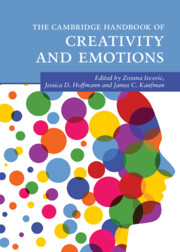Book contents
- The Cambridge Handbook of Creativity and Emotions
- Cambridge Handbooks in Psychology
- The Cambridge Handbook of Creativity and Emotions
- Copyright page
- Dedications
- Contents
- Figures
- Tables
- Contributors
- Acknowledgments
- Creativity and Emotions
- Part I Methods in the Study of Creativity and Emotions
- 1 Experimental Methods in the Study of Emotions and Creativity
- 2 Affect, Complexity, and the Case Study Method
- 3 Observational Methods in the Study of Creativity and Emotions
- 4 Assessing Creativity and Affect in Everyday Environments
- Part II The Development of Creativity
- Part III Emotions and the Creative Person
- Part IV Emotions and Creative Products
- Part V Emotions and Creativity at School and Work
- Index
- References
4 - Assessing Creativity and Affect in Everyday Environments
Experience-Sampling and Daily Diary Methods
from Part I - Methods in the Study of Creativity and Emotions
Published online by Cambridge University Press: 16 February 2023
- The Cambridge Handbook of Creativity and Emotions
- Cambridge Handbooks in Psychology
- The Cambridge Handbook of Creativity and Emotions
- Copyright page
- Dedications
- Contents
- Figures
- Tables
- Contributors
- Acknowledgments
- Creativity and Emotions
- Part I Methods in the Study of Creativity and Emotions
- 1 Experimental Methods in the Study of Emotions and Creativity
- 2 Affect, Complexity, and the Case Study Method
- 3 Observational Methods in the Study of Creativity and Emotions
- 4 Assessing Creativity and Affect in Everyday Environments
- Part II The Development of Creativity
- Part III Emotions and the Creative Person
- Part IV Emotions and Creative Products
- Part V Emotions and Creativity at School and Work
- Index
- References
Summary
Creativity can be seen in many facets of our lives, from experimenting with your dinner recipes or using ingenuity to resolve problems to inventing a new technology or working as a professional artist. Researchers are increasingly moving beyond investigating creativity in the lab to examine how and when creativity occurs in people’s everyday lives and environments. This chapter provides an overview of ecological momentary assessment techniques (i.e., daily dairy and experience sampling methods) commonly used in creativity research. To illustrate how ecological momentary assessment methods have featured in creativity research, I review several exemplars of research focused on creativity in daily life.
- Type
- Chapter
- Information
- The Cambridge Handbook of Creativity and Emotions , pp. 68 - 84Publisher: Cambridge University PressPrint publication year: 2023



